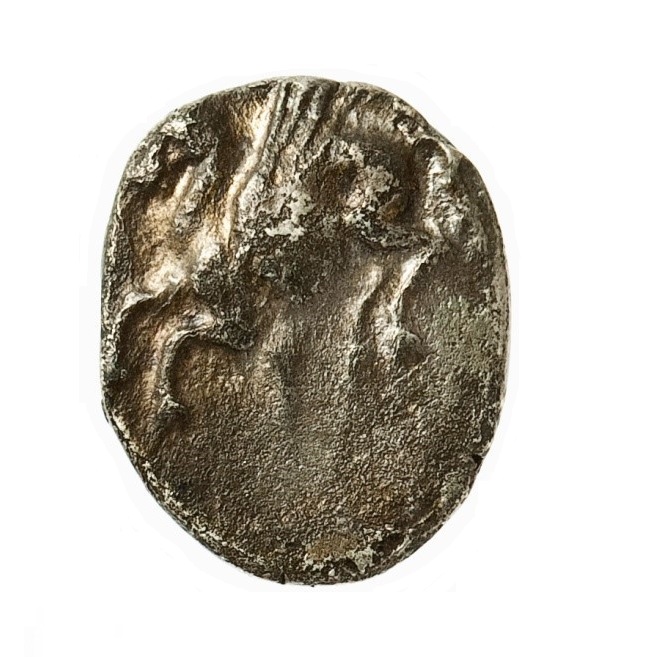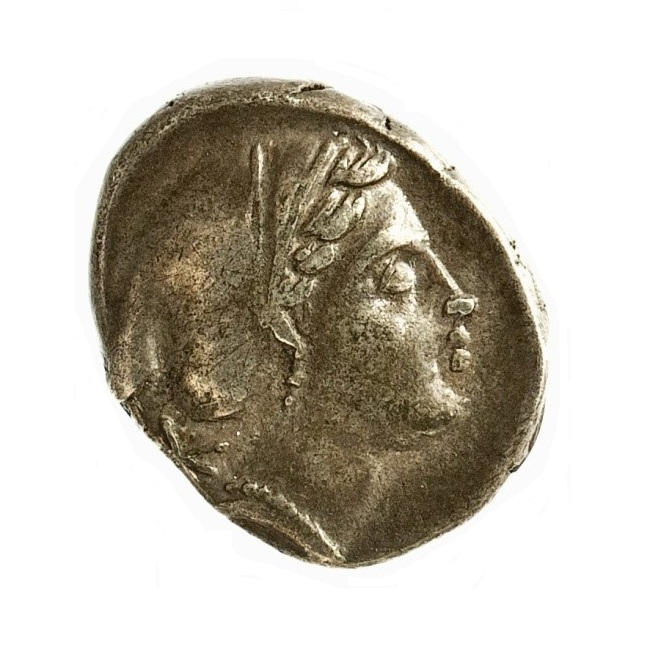Title: Hemidrachmon of Corinth - 1973.27
Acquisition number: 1973.27
Author or editor: Douglas Kelly
Culture or period: Classical Greece.
Date: c. 400 - 338 BC.
Material: Metal - Silver
Object type: Coins - Greek
Dimensions: 13mm (w)
Origin region or location: Greece
Origin city: Corinth.
Display case or on loan: 5
Keywords: Coin, Greek, hemidrachmon, Pegasos, Pegasus, Aphrodite, Artemis, Peirene
Numismatik Lanz, Münzen von Korinth: Sammlung B (Auction 105 [26 November 2001], Munich, Numismatik Lanz, 2001), 174.
Sylloge Nummorum Graecorum, Copenhagen, The Royal Collection of Coins and Medals, Danish National Museum, repr. edn (West Milford, NJ, 1981-), 139, 140.
B.V. Head and R.S. Poole, Catalogue of Greek Coins: Corinth (London, The British Museum, 1889), p. 19 no. 192.
C.M. Kraay, Archaic and Classical Greek Coins (London, Methuen, 1976), 78 - 85.
J. B. Salmon, Wealthy Corinth: A History of the City to 338 BC (Oxford, 1984), pp.170-174.
1973.27
Hemidrachmon of Corinth
Silver 2.37 g. 13 mm. c. 400-338 BC.
Obv.: Winged Pegasos flying l.
Rev.: Head of goddess r.
The unhelmeted female head that appears on the obverse of the drachma and lower-value silver coins of Corinth from c. 520/510 BC onwards has sometimes been identified as Aphrodite, but unless the head of a goddess is accompanied by some clear attribute, such as Artemis’s bow or Aphrodite’s jewellery, it is often unclear which particular goddess is represented. This female head may be Aphrodite (although a clearly-attested Aphrodite does not appear on any other coins of Corinth), but other goddesses are possible: for example, Artemis or, more probably, Peirene, the nymph-goddess of the sacred spring that was prominently situated in the agora at Corinth.
The major cult at Corinth was that of Poseidon, celebrated with Panhellenic Games, the Isthmia, held at a great sanctuary on the Isthmus of Corinth every two years. Oddly, Poseidon, whose temple was the largest in the land of Corinth, never appears on its coinage before the destruction of Corinth in 146 BC. In contrast, Poseidon and Aphrodite commonly appear on the coinage of Roman Corinth (refounded c. 44 BC).
Helmeted Athena does appear on the obverse of Corinthian drachmas and hemidrachma, but Athena is the easiest goddess to recognise on coins (cf. 1967.15). Athena played a leading part in the legend of the creation of the winged horse Pegasus for the hero Bellerophon, a legend placed in Ephyra, which was believed to have been the early name for Corinth. This legend, which was Corinth’s most celebrated link with the heroic age, a mythical period of enormous importance to Greek states, provided images for Corinthian coinage.
Numismatik Lanz, Münzen von Korinth: Sammlung B (Auction 105 [26 November 2001], Munich, Numismatik Lanz, 2001), 174.
Sylloge Nummorum Graecorum, Copenhagen, The Royal Collection of Coins and Medals, Danish National Museum, repr. edn (West Milford, NJ, 1981-), 139, 140.
B.V. Head and R.S. Poole, Catalogue of Greek Coins: Corinth (London, The British Museum, 1889), p. 19 no. 192.
C.M. Kraay, Archaic and Classical Greek Coins (London, Methuen, 1976), 78 - 85.
J. B. Salmon, Wealthy Corinth: A History of the City to 338 BC (Oxford, 1984), pp.170-174.

